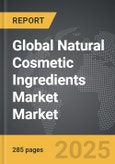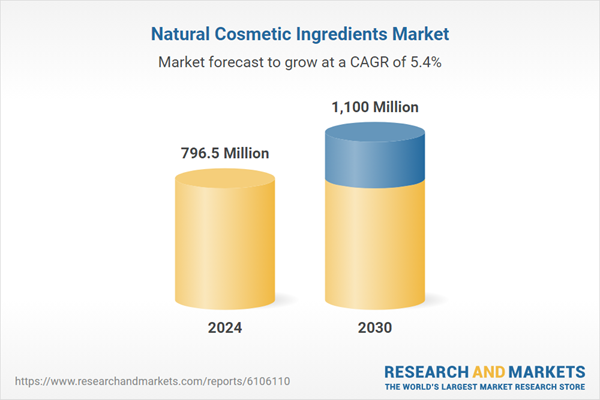Global Natural Cosmetic Ingredients Market - Key Trends & Drivers Summarized
Why Are Natural Cosmetic Ingredients Gaining Preference Among Manufacturers and Consumers?
Natural cosmetic ingredients are becoming integral to product formulation as demand grows for clean-label, sustainable, and skin-friendly alternatives to synthetic chemicals. These ingredients are derived from plants, minerals, or other natural sources and are used in skincare, haircare, color cosmetics, and personal hygiene products. Consumers increasingly associate natural ingredients with safety, transparency, and environmental responsibility. This shift is influencing brands to reformulate existing products and develop new lines that feature botanical extracts, essential oils, natural emulsifiers, and bioactive compounds.Ingredients such as aloe vera, shea butter, green tea, turmeric, jojoba oil, and chamomile are widely used for their moisturizing, antioxidant, anti-inflammatory, and soothing properties. Demand is also growing for natural exfoliants like fruit enzymes, coffee grounds, and crushed seeds, replacing microplastics. This consumer-led transition is supported by growing awareness of ingredient sourcing, product labeling, and wellness-oriented lifestyles. The appeal of minimal processing, biodegradability, and eco-certification is shaping both product design and purchase decisions.
How Are Formulation Innovations Enhancing Efficacy and Market Adoption?
Advancements in extraction and processing techniques are enabling higher purity, stability, and efficacy of natural ingredients. Cold-press extraction, fermentation, and supercritical CO2 extraction are being used to retain the active compounds while avoiding chemical degradation. Green chemistry principles are influencing emulsifier and preservative selection, reducing the reliance on synthetic additives while maintaining product shelf life and performance.Functional innovation is extending the use of natural ingredients into anti-aging, brightening, acne control, and sun protection applications. Plant-based peptides, enzymes, and antioxidants are being incorporated to deliver targeted benefits. Formulators are also combining multiple botanical extracts to create synergistic effects that address multiple skin or hair concerns. The industry is witnessing a shift toward waterless and preservative-free formats, such as solid cleansers and oil-based serums, which naturally align with plant-derived ingredient systems.
Which Product Categories and Consumer Segments Are Driving Demand?
Skincare is the leading segment for natural cosmetic ingredients, followed by haircare and color cosmetics. Consumers increasingly look for botanical-based cleansers, face oils, toners, and moisturizers. In haircare, products containing coconut oil, argan oil, and herbal infusions are popular for nourishment and scalp health. In decorative cosmetics, brands are exploring natural pigments derived from beetroot, turmeric, and minerals to replace synthetic dyes.Demand is growing across both premium and mass-market categories. Gen Z and millennial consumers show a strong inclination toward eco-conscious and ethical brands. Male grooming products with natural formulations are also expanding, particularly in beard care and face care categories. The baby care and sensitive skin markets rely heavily on gentle, natural ingredients. Growth is supported by specialty retailers, wellness platforms, and online channels offering curated and certified product lines.
Growth in the Natural Cosmetic Ingredients Market Is Driven by Several Factors…
Growth in the natural cosmetic ingredients market is driven by several factors. Rising consumer demand for clean-label, plant-based, and eco-friendly cosmetics influences product development across all categories. Advances in green extraction and formulation technologies improve stability, efficacy, and product appeal. Regulatory focus on ingredient safety and permissible claims encourages transparency and reformulation. Growing awareness of environmental sustainability supports interest in biodegradable, renewable, and cruelty-free raw materials. Expansion of e-commerce and wellness-driven marketing drives consumer access and engagement. Lastly, evolving certification systems and industry standards support brand differentiation and consumer trust in natural ingredient claims.Report Scope
The report analyzes the Natural Cosmetic Ingredients market, presented in terms of market value (US$). The analysis covers the key segments and geographic regions outlined below:- Segments: Ingredient (Emollients Ingredient, Bio Surfactants Ingredient, Sugar Polymers Ingredient, Natural Preservatives Ingredient, Other Ingredients); Application (Skin Care Application, Hair Care Application, Make-Up Application, Oral Care Application, Other Applications).
- Geographic Regions/Countries: World; United States; Canada; Japan; China; Europe (France; Germany; Italy; United Kingdom; Spain; Russia; and Rest of Europe); Asia-Pacific (Australia; India; South Korea; and Rest of Asia-Pacific); Latin America (Argentina; Brazil; Mexico; and Rest of Latin America); Middle East (Iran; Israel; Saudi Arabia; United Arab Emirates; and Rest of Middle East); and Africa.
Key Insights:
- Market Growth: Understand the significant growth trajectory of the Emollients Ingredient segment, which is expected to reach US$474 Million by 2030 with a CAGR of a 5.8%. The Bio Surfactants Ingredient segment is also set to grow at 4.2% CAGR over the analysis period.
- Regional Analysis: Gain insights into the U.S. market, valued at $217 Million in 2024, and China, forecasted to grow at an impressive 8.6% CAGR to reach $219.9 Million by 2030. Discover growth trends in other key regions, including Japan, Canada, Germany, and the Asia-Pacific.
Why You Should Buy This Report:
- Detailed Market Analysis: Access a thorough analysis of the Global Natural Cosmetic Ingredients Market, covering all major geographic regions and market segments.
- Competitive Insights: Get an overview of the competitive landscape, including the market presence of major players across different geographies.
- Future Trends and Drivers: Understand the key trends and drivers shaping the future of the Global Natural Cosmetic Ingredients Market.
- Actionable Insights: Benefit from actionable insights that can help you identify new revenue opportunities and make strategic business decisions.
Key Questions Answered:
- How is the Global Natural Cosmetic Ingredients Market expected to evolve by 2030?
- What are the main drivers and restraints affecting the market?
- Which market segments will grow the most over the forecast period?
- How will market shares for different regions and segments change by 2030?
- Who are the leading players in the market, and what are their prospects?
Report Features:
- Comprehensive Market Data: Independent analysis of annual sales and market forecasts in US$ Million from 2024 to 2030.
- In-Depth Regional Analysis: Detailed insights into key markets, including the U.S., China, Japan, Canada, Europe, Asia-Pacific, Latin America, Middle East, and Africa.
- Company Profiles: Coverage of players such as Agilent Technologies, Inc., BGI Genomics Co., Ltd., CD-Genomics, Electronic Biosciences, Inc., Eurofins Scientific and more.
- Complimentary Updates: Receive free report updates for one year to keep you informed of the latest market developments.
Some of the 36 companies featured in this Natural Cosmetic Ingredients market report include:
- Ashland Inc.
- BASF SE
- Cargill, Incorporated
- Clariant AG
- Croda International Plc
- Dow Inc.
- DSM Nutritional Products
- Evonik Industries AG
- Gattefossé
- Givaudan SA
- Inolex
- Kerry Group plc
- Laboratoires Expanscience
- Lucas Meyer Cosmetics
- Lubrizol Corporation
- Naturex (Givaudan brand)
- Seppic (Air Liquide)
- Silab
- Solabia Group
- Symrise AG
- Weleda AG
This edition integrates the latest global trade and economic shifts into comprehensive market analysis. Key updates include:
- Tariff and Trade Impact: Insights into global tariff negotiations across 180+ countries, with analysis of supply chain turbulence, sourcing disruptions, and geographic realignment. Special focus on 2025 as a pivotal year for trade tensions, including updated perspectives on the Trump-era tariffs.
- Adjusted Forecasts and Analytics: Revised global and regional market forecasts through 2030, incorporating tariff effects, economic uncertainty, and structural changes in globalization. Includes historical analysis from 2015 to 2023.
- Strategic Market Dynamics: Evaluation of revised market prospects, regional outlooks, and key economic indicators such as population and urbanization trends.
- Innovation & Technology Trends: Latest developments in product and process innovation, emerging technologies, and key industry drivers shaping the competitive landscape.
- Competitive Intelligence: Updated global market share estimates for 2025, competitive positioning of major players (Strong/Active/Niche/Trivial), and refined focus on leading global brands and core players.
- Expert Insight & Commentary: Strategic analysis from economists, trade experts, and domain specialists to contextualize market shifts and identify emerging opportunities.
Table of Contents
Companies Mentioned (Partial List)
A selection of companies mentioned in this report includes, but is not limited to:
- Ashland Inc.
- BASF SE
- Cargill, Incorporated
- Clariant AG
- Croda International Plc
- Dow Inc.
- DSM Nutritional Products
- Evonik Industries AG
- Gattefossé
- Givaudan SA
- Inolex
- Kerry Group plc
- Laboratoires Expanscience
- Lucas Meyer Cosmetics
- Lubrizol Corporation
- Naturex (Givaudan brand)
- Seppic (Air Liquide)
- Silab
- Solabia Group
- Symrise AG
- Weleda AG
Table Information
| Report Attribute | Details |
|---|---|
| No. of Pages | 285 |
| Published | November 2025 |
| Forecast Period | 2024 - 2030 |
| Estimated Market Value ( USD | $ 796.5 Million |
| Forecasted Market Value ( USD | $ 1100 Million |
| Compound Annual Growth Rate | 5.4% |
| Regions Covered | Global |









